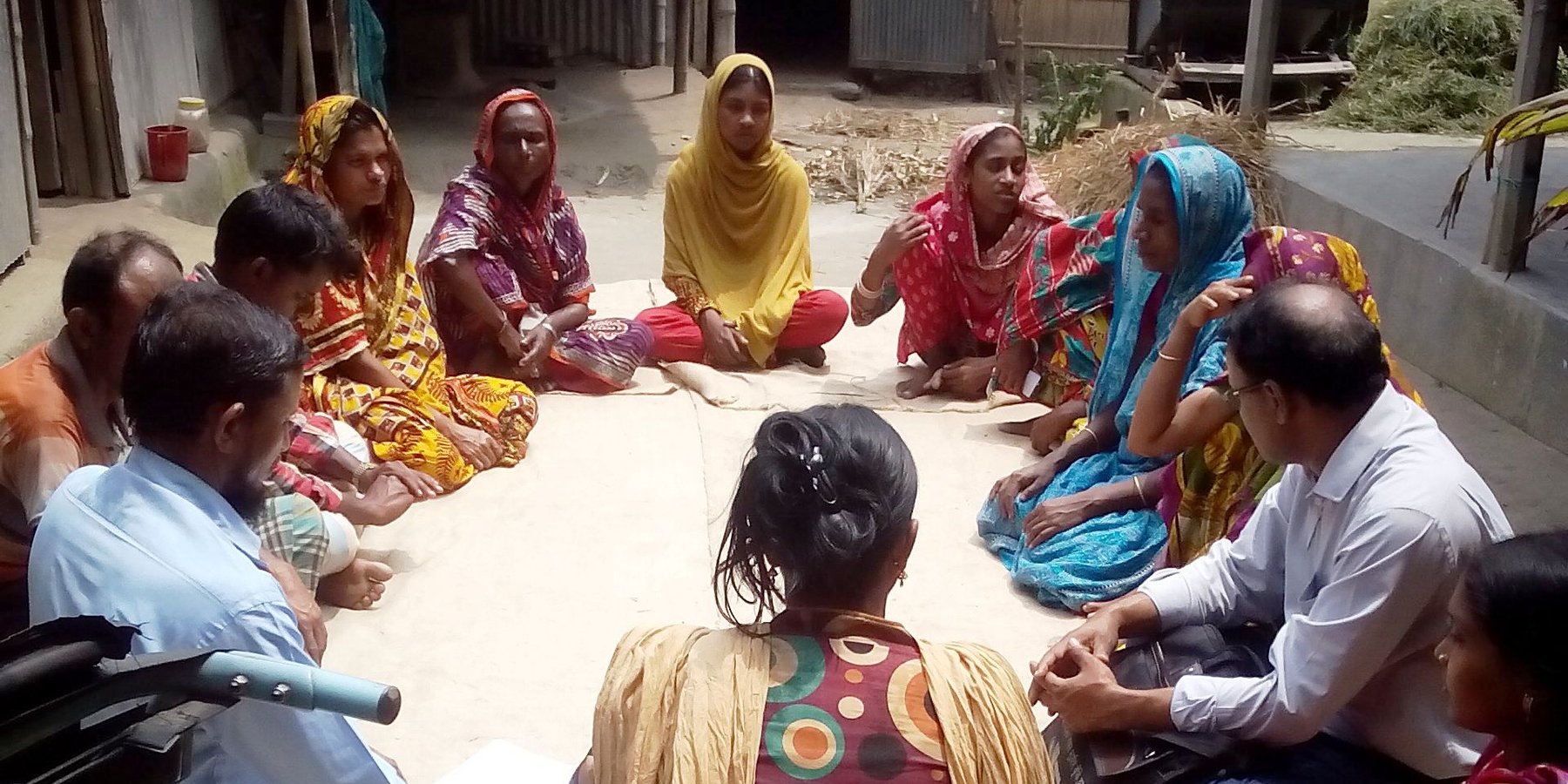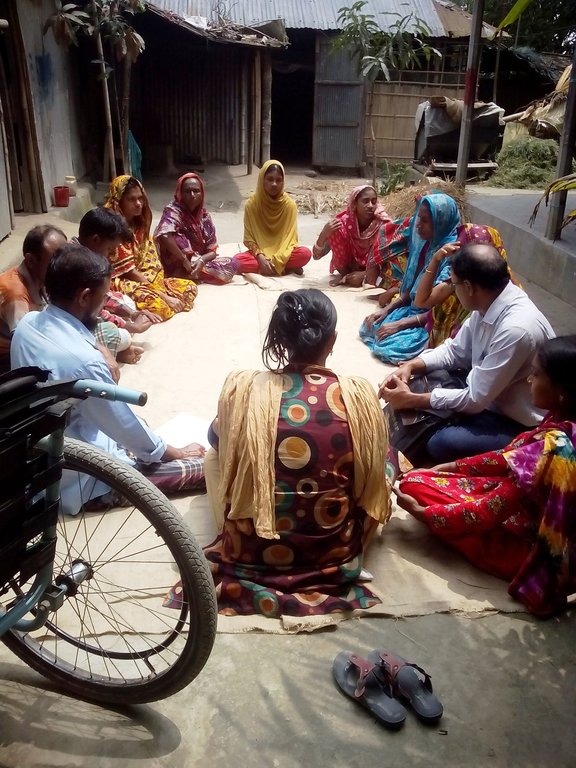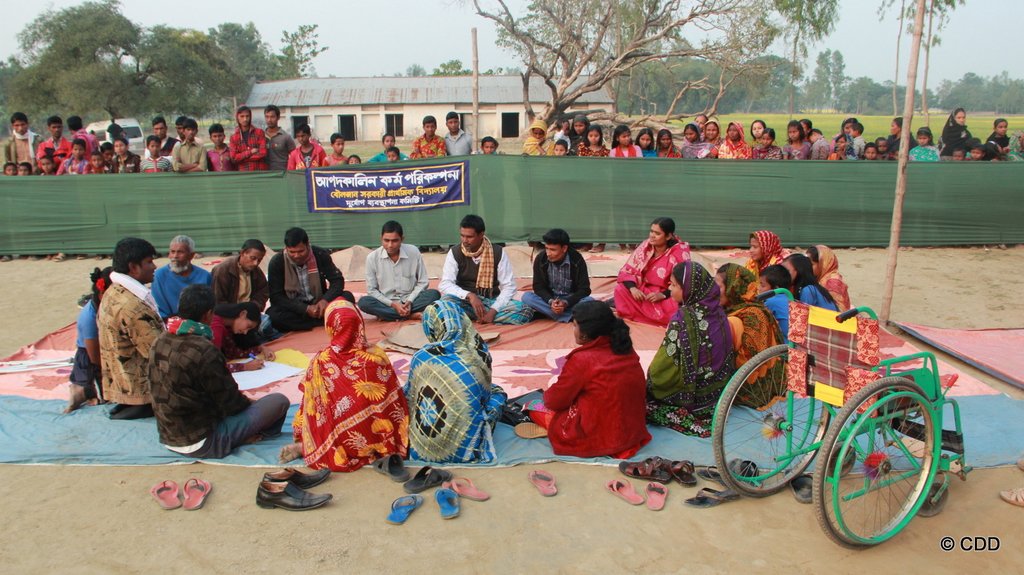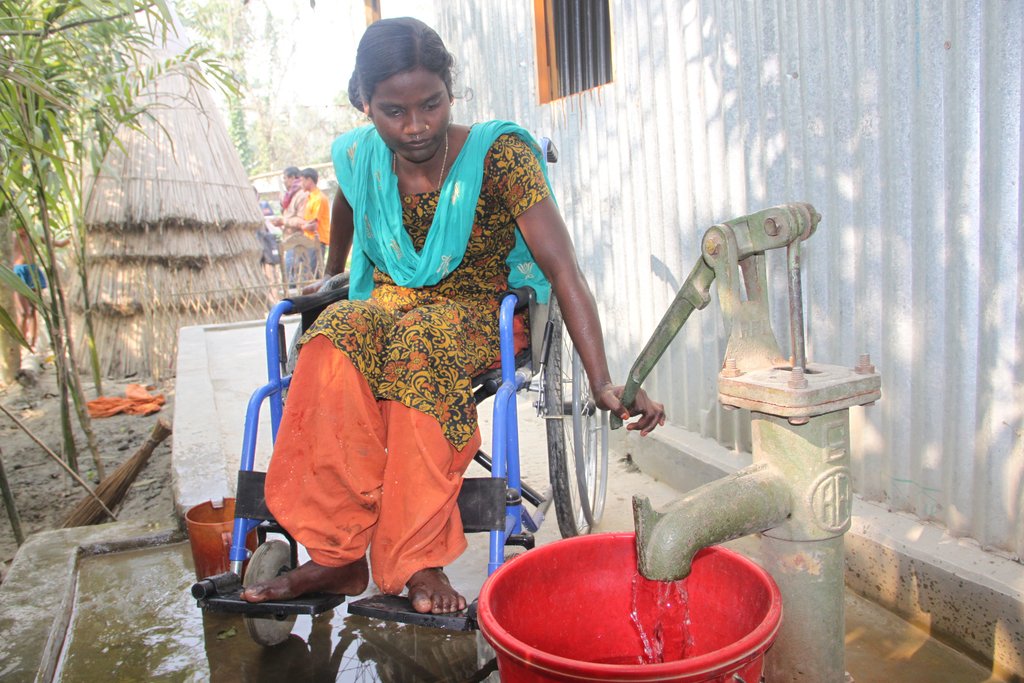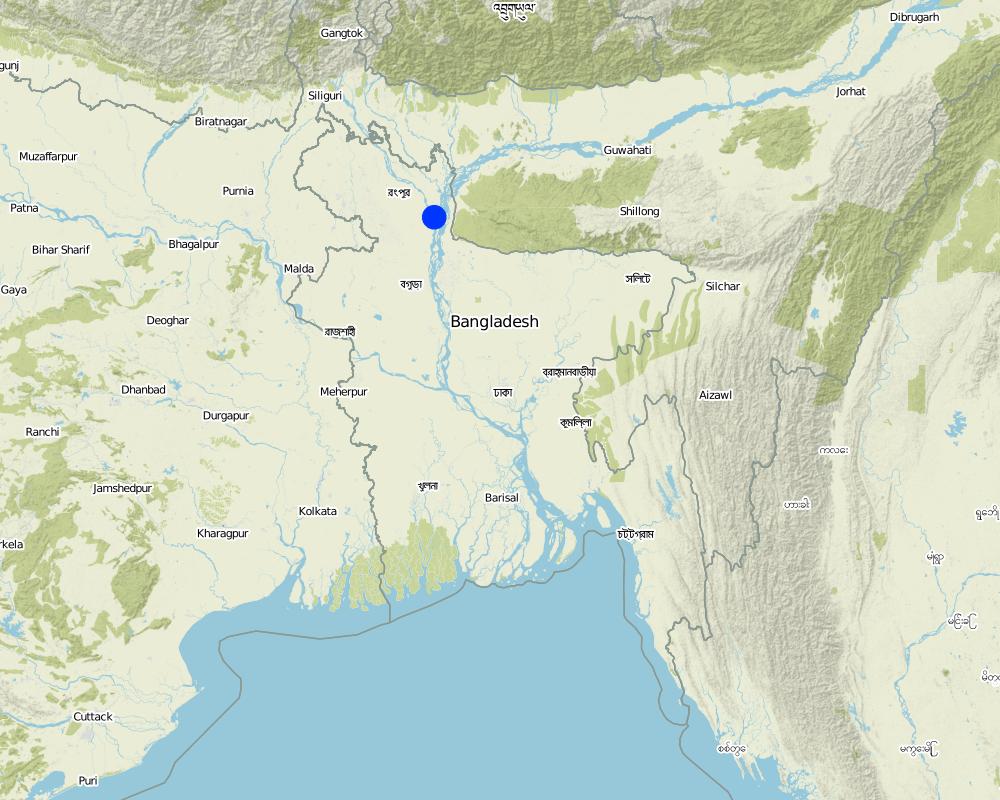Disability inclusive Disaster Risk Reduction [Бангладеш]
- Создание:
- Обновить:
- Составитель: Subir Saha
- Редакторы: Manuel Rothe, Subir Saha
- Рецензент: Alexandra Gavilano
Protibondhita Bandhob Durjog Jhuki Rash
approaches_2001 - Бангладеш
Просмотреть разделы
Развернуть все Свернуть все1. Общая информация
1.2 Контактные данные специалистов и организаций, участвующих в описании и оценке Подхода
DRR specialist:
Islam Shahidul
+8801733143435
shahidulpls@yahoo.com
Centre for Disability in Development (CDD)
Gaibandha
Бангладеш
DRR specialist:
Dey Ashutosh
880-2-9887251 / +8801787662993
ashutosh.dey@cbm.org
CBM
Country Coordination Office CBM International H # 12 (GF) R # 2/A, Block-F Banani, Dhaka-1213
Бангладеш
DRR Specialist:
Название проекта, содействовавшего документированию/оценке Подхода (если применимо)
Book project: where people and their land are safer - A Compendium of Good Practices in Disaster Risk Reduction (DRR) (where people and their land are safer)Название организации (-ий), содействовавших документированию/оценке Подхода (если применимо)
Christoffel Blindenmission (CBM) - Швейцария1.3 Условия, регламентирующие использование собранных ВОКАТ данных
Когда были собраны данные (на местах)?
09/11/2016
Составитель и ответственный/-ые специалист(-ы) согласны с условиями, регламентирующими использование собранных ВОКАТ данных:
Да
1.4 Ссылка (-и) на Анкету (-ы) по Технологиям УЗП
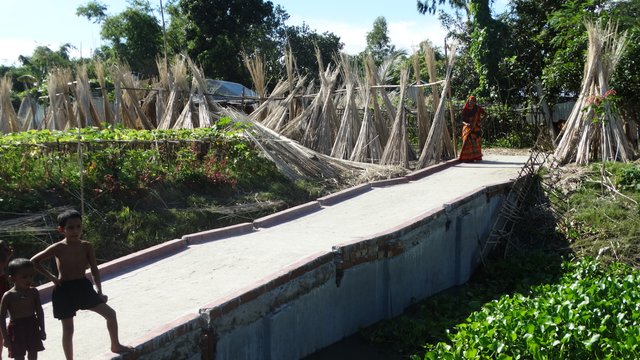
Disability inclusive, flood resilient cluster village [Бангладеш]
The inclusive, flood-resilient cluster village provides safe housing, food security and income generation for multiple families, including persons with disabilities, in a highly flood prone area of Gaibandha District in northern Bangladesh. The land was raised above flood level and is protected by deep rooted fruit trees to prevent soil …
- Составитель: Subir Saha
2. Описание Подхода УЗП
2.1 Краткое описание Подхода
The disability inclusive approach is centered around the meaningful contribution and leadership of persons with disabilties during the entire project management cycle, from the planning stage to the evaluation of the impact of a project. It contributes to empowering them to overcome social exclusion and recognizes their needs and priorities as persons who are disproportionally at risk of disaster.
2.2 Подробное описание Подхода
Подробное описание Подхода:
The main charactistic and central feature of the approach is that persons with disabilties can actively and meaningfully participate in, contribute to and benefit from sustainable land management/disaster risk reduction activities. The implementing organization needs to invest sufficient time and financial ressources into the formation and strenthening of self-representation groups of persons with disabilities and support their active engagement with the local government and the wider community to address the physical and attitudinal barriers that hinder their full participation in the project and society in general.
The aim is twofold: On the one hand, the participation of persons with disabitities ensures that their needs and priorities are fully taken into account in the project design and implementation, to ensure that they can benefit equally from it. On the other hand, it contributes to reducing barriers beyond the project and empowers them to demand their rights in other areas of human development, like education, health or livelihood.
The main stages of disability inclusion in the implementation of a SLM/DRR technology are:
1) Formation of self-help groups for persons with disabilities,
2) trainings and other capacity development activities for the groups, including rights awareness sessions and organizational management trainings,
3) set up the collaboration between the groups and the local government and with other members of the community,
4) participation of persons with disabilities/group members in the planning phase to decide on the technology and adapt the technology to universal design standards, which takes into account their needs and the needs of other groups with other specific accessiblity needs, like the elderly or pregnant women,
5) persons with disabilities (together with other land users) support the introduction of the technology (including the construction activities) by providing manual labor and supervision functions
6) full handover of the technology to land users, ensuring Joint ownership includes persons with disabilities, and provision of trainings for self-maintenance,
7) participation of persons with disabilties in the evaluation of the impact of the technology, sharing of lessons and good practices and continuous advocacy for community development and for the rights of persons with disabilties.
Experience from Bangladesh shows that what the land users, including persons with disabilties, like about the approach is: The strong community engagement, the empowerment and increased status of persons with disabilities, the collaboration between persons with disabilities and persons without disability, and the adaptation of existing technology to fit the needs of persons with disability.
2.3 Фотографии, иллюстрирующие Подход
2.5 Страна/ регион/ место, где применялся Подход
Страна:
Бангладеш
Административная единица (Район/Область):
Gaibandha District
Более точная привязка места:
Horipur Union, Sundargonj Sub district
Map
×2.6 Даты начала и окончания реализации Подхода
Год начала реализации:
2015
Год окончания (Если Подход больше не применяется):
2016
Комментарии:
Project "Disability inclusive, flood resilient cluster village" implemented from December 2015 to September 2016.
2.7 Тип Подхода
- в рамках проекта/ программы
2.8 Каковы цели/ задачи Подхода
To empower persons with disabilities to meaningfully participate in, contribute to and benefit from the implementation of an SLM/DRR technology.
2.9 Условия содействующие применению Технологии/ Технологий в рамках Подхода или затрудняющие его
Социальные/ культурные/ религиозные нормы и ценности
- затрудняют
The social stigma and exclusion, that persons with disabilities experience in rural Bangladesh, was a challenge for the project. Persons with disabilities are sometimes believed to be incapable of contributing anything meaningful to society and village life. Some community members did not want to associate with persons with disabilities. This required an extra effort to ensure the participation of the wider community in the project and it required sustained advocacy and awareness raising for the rights and dignity of persons with disabilities.
Наличие/ доступность финансовых ресурсов и услуг
- содействуют
The financial resources for the implementation of the technology and the extra ressources needed to ensure disability inclusion, were readily available because the technology was widely and positively recognized by the community and by donors.
Институциональные условия
- содействуют
The institutional environment was overwhelmingly supportive of the implementation of the project. The local Union Council government, schools, mosques and other civil society organizations were in favor of the technology and approach and supported the implementation.
Сотрудничество/ координация действий
- содействуют
Beneficiaries/land users were selected in a participative process, involving the whole community. The process was transparent and inclusive. It was a foundation for the smooth collaboration with beneficiaries and other involved stakeholders later on.
Нормативно-правовая база (землевладение, права на земле- и водопользование)
- содействуют
To ensure joint ownership of beneficiaries of the land on which the SLM/DRR Technology was implemented, an exchange of land was needed. Due to the remoteness and scarce population of the implementation area in rural Bangladesh, a cooperative local government and a manageable legal framework this was easy to achieve.
A deep-rooted tube well was installed for water access of the land users. Water use rights were also easy to acquire.
Программные документы/ руководящие установки
- содействуют
No specific policies existed, which significantly affected the implementation of the technology.
Управление земельными ресурсами (принятие решений, осуществление и контроль за выполнением)
- содействуют
Land ownership was recognized by the local government and land governance was controlled by land owners.
Осведомленность в области УЗП, доступность технической поддержки
- содействуют
Indigenous knowledge about SLM was enabling for the implementation of the technology. Technical expertise by the implementing organization (NGO) was available.
Рынки (для приобретения материалов и услуг, продажи продукции) и цены
- содействуют
Inputs for construction and planting were locally available at reasonable prices.
Объем работ, доступность рабочей силы
- содействуют
During the lean season manpower was abundant in the area, but it was scarce during the planting season. The workload for the implementation of the technology was manageable and could easily be provided by land users themselves.
3. Участие и распределение ролей заинтересованных сторон
3.1 Заинтересованные стороны, участвующие в реализации Подхода и их роли
- местные землепользователи/ местные сообщества
The land users include 10 families who jointly own and inhabit the land of the cluster village.
Land users were closely engaged in the implementation of the technology by participating in decision making processes, informing the design of the technology and contributing to the construction process.
- организации местных сообществ
Self-help (self-representation) groups of persons with disabilities are informal community based groups of 15 persons with different types of disabilities (physical-, sensory- and mental disabilities).
The group is closely engaged in the implementation of the technology. It participates in decision making processes, informs the design of the technology, contributes to the construction process, is engaged in the evaluation of the technology and the sharing of learnings about it to the wider community.
The group also provides benefits for its members by supporting them with everyday challenges, which can be of economic, legal or social nature, and promotes the rights of all persons with disabilities in the community.
- общественные организации
The implementing NGOs included an international and a local organization in partnership (CBM and CDD).
CDD was responsible for the overall management of project implementation and the collaboration with other involved local stakeholders. CBM provided training and technical support.
- местные власти
The Union Parishad government is the lowest level of local government.
The Union Parishad government managed land ownership and approved construction projects.
3.2 Участие местных землепользователей/ местных сообществ на разных стадиях реализации Подхода
| Участие местных землепользователей/ местных сообществ | Перечислите участников и опишите их вовлеченность | |
|---|---|---|
| инициирование/ мотивация | интерактивное | Land users contributed to the initial situation analysis and joined self-help groups for persons with disabilities. |
| планирование | интерактивное | Land users, and in particular those who are persons with disabilities, participated in all planning and decision making processes related to the design and introduction of the technology, including the selection of the land. |
| выполнение | внешняя поддержка | Land users engaged in the construction of the technology by providing paid and unpaid labor. |
| мониторинг/ оценка | интерактивное | The land users monitored the implementation process and gave feedback to the implementing NGOs when changes were needed. Land users participated in the evaluation of the technology and the approach and contributed to the dissemination of good practices and learnings. |
3.3 Схема реализации (если имеется)
Описание:
Not available.
3.4 Принятие решений по выбору Технологии/ Технологий УЗП
Укажите, кто принимал решение по выбору применяемой Технологии/ Технологий:
- все участники как часть процесса совместных действий
Поясните:
The cluster village technology was known to the community before the implementation. The technology was suggested by the implementing NGOs to the community, which supported its implementation. The technology was adapted to fit the needs of persons with disabilities based on the decisions of land users with technical support of the implementing NGOs.
Поясните на чём было основано принятие решений:
- анализ подробно описанного опыта и знаний по УЗП (принятие решений на основе подтвержденных фактов)
4. Техническая поддержка, повышение компетенций и управление знаниями
4.1 Повышение компетенций/ обучение
Проводилось ли обучение землепользователей/ других заинтересованных лиц?
Да
Укажите, кто проходил обучение:
- землепользователи
- местный персонал/консультанты
Если существенно, укажите гендерный и возрастной состав, статус, этническую принадлежность и т.д.
10 males and 15 females, aged between 18 to 55. Three were persons with disabilities. Most of them were daily laborers and share croppers.
Тип обучения:
- в ходе работы
- опытные участки
- курсы
Рассматриваемые темы:
On the job training and demonstration on the construction and maintenance of the technology. Training to self-help groups for persons with disabilities on the rights of persons with disabilities, the use and benefits of the technology for persons with disabilities and the management of self-help groups.
Комментарии:
Training Subjects were: 1) Group dynamics and Development, 2) Disability inclusive DRR 3) Tree plantation and Vegetable Gardening using organic fertilizer 4) Government safety nets and Rights of the persons with disabilities.
4.2 Консультационные услуги
Есть ли у землепользователей возможность получать консультации?
Да
Укажите, где именно оказываются консультационные услуги:
- на полях землепользователей
- construction/implementation of technology
Описание/ комментарий:
The implementing NGOs provided detailed technical support to land users on the adaptation of the technology to the needs of persons with disabilities, following the standards of universal design.
4.3 Институциональная (организационная) поддержка
В ходе реализации Подхода были ли организованы новые институциональные структуры или поддержаны уже существующие?
- да, умеренно
Укажите уровень, на котором структуры были укреплены или вновь созданы:
- местные
Опишите организацию, функции и ответственность, членство и т.д.
Local self-help groups and their APEX body (umbrella group) at Union level were strengthened. Their roles of the self-help groups were to establish a mutual support network, raise awareness among group members of disability rights and development issues, pool ressources and give individual persons with disabilities a greater political voice. The APEX body gave the groups contact points beyond their immediate community and gave further weight to their political voice.
Укажите тип поддержки:
- финансовая
- повышение компетенций/ обучение
- оборудование
Подробнее:
To strengthen self-help groups, they were provided with, 1) awarness- and skill development trainings, 2) financial support for climate resilient income generation through agricultural and non-agricultural activities, and 3) assistive devices.
4.4 Мониторинг и оценка
Являются ли мониторинг и оценка частью Подхода?
Да
Комментарии:
A participatory monitoring and evaluation system was implemented with support of the self-help groups for persons with disabilties.
Если да, будет ли данный документ использоваться для мониторинга и оценки?
Нет
4.5 Научные исследования
Были ли научные исследования частью Подхода?
Нет
5. Финансирование и внешняя материальная поддержка
5.1 Годовой бюджет мероприятий по УЗП в рамках Подхода
Укажите годовой бюджет мероприятий УЗП в рамках Подхода в долларах США :
218702,00
Если точный годовой бюжет неизвестен, укажите примерный диапазон затрат:
- 100 000-1 000 000
Комментарий (например, основные источники финансирования/ ключевые доноры):
The annual budget includes the total funds used for the introduction of the technology. Funds were provided through the implementing NGOs CBM and CDD, with the support of a private donor from Germany.
5.2 Финансирование и внешняя материальная поддержка, предоставляемая землепользователям
Предоставлялась ли землепользователям финансовая/ материальная поддержка для применения Технологии /Технологий?
Да
Если да, укажите тип(-ы) поддержки, кто ее предоставил и условия предоставления:
Land users received a daily fee for the labor provided for the introduction of the technology. The NGOs also provided most material input for the technology, including soil, sand, seeds, seedlings, grass, trees, ramp, water and sanitation facilties.
5.3 Субсидии на отдельные затраты (включая оплату труда)
- труд
| В какой степени | Опишите субсидии подробнее |
|---|---|
| профинансированы частично | Labor provided by land users for certain construction actvities was compensated with a daily fee. |
- оборудование
| Укажите, какие ресурсы были субсидированы | В какой степени | Опишите субсидии подробнее |
|---|---|---|
| техника | профинансированы полностью | Rent of sand extravation machine was funded by the project. |
| инвентарь/ инструменты | профинансированы полностью | Tools for construction activities was provided to land users by the project. |
- сельскохозяйственные
| Укажите, какие ресурсы были субсидированы | В какой степени | Опишите субсидии подробнее |
|---|---|---|
| семена | профинансированы полностью | Seeds and seedlings for the homestead garden was provided by the project. |
| удобрения | профинансированы частично | The facility for composting organic fertilizer was provided by the project. |
| Plants | профинансированы полностью | Deep-rooted fruit trees and grass turfing was provided by the project. |
- строительные материалы
| Укажите, какие ресурсы были субсидированы | В какой степени | Опишите субсидии подробнее |
|---|---|---|
| древесина | профинансированы частично | Wood for fencing for the homestead vegetable garden in front of all houses and a flood resilient cow sheds in the village was provided by the project. |
| Soil | профинансированы полностью | The purchase of soil for the raising of land was funded by the project. |
- инфраструктура
| Укажите, какие ресурсы были субсидированы | В какой степени | Опишите субсидии подробнее |
|---|---|---|
| дороги | профинансированы частично | Construction material for barrier free connections to all houses in the village was funded by the project. |
| Ramp | профинансированы полностью | A ramp, connecting the cluster village with the road was funded by the project. |
Если труд землепользователя был существенным вкладом, укажите, был ли этот вклад:
- за денежное вознаграждение
Комментарии:
A daily fee of 300 Taka was provided for labor inputs by the land users.
5.4 Кредитование
Предоставлялись ли в рамках Подхода кредиты на мероприятия УЗП?
Нет
5.5 Другие методы или инструменты стимулирования
Использовались ли другие методы или инструменты стимулирования для продвижения Технологий УЗП?
Нет
6. Анализ влияния и заключительные положения
6.1 Влияние Подхода
Сумел ли Подход расширить возможности местных землепользователей, повысить участие заинтересованных сторон?
- Нет
- Да, немного
- Да, умеренно
- Да, существенно
The approach is based on the empowerment of land users, in particularly those who are persons with disabilites. It ensured participation of persons with disablities who would otherwise be isolated and excluded.
Сумел ли Подход дать возможность принимать решения на основе подтвержденных фактов?
- Нет
- Да, немного
- Да, умеренно
- Да, существенно
Сумел ли Подход помочь землепользователям внедрить и поддерживать технологии УЗП?
- Нет
- Да, немного
- Да, умеренно
- Да, существенно
The project supported land users with the implementation and use of the technology.
Сумел ли Подход улучшить согласованность действий и повысить рентабельность применения практик УЗП:
- Нет
- Да, немного
- Да, умеренно
- Да, существенно
The coordination among land users has improved and actions of land management have become more cost effective.
Сумел ли Подход мобилизовать/ расширить доступ к финансовым ресурсам для применения практик УЗП?
- Нет
- Да, немного
- Да, умеренно
- Да, существенно
Сумел ли Подход расширить знания и возможности землепользователей в применении практик УЗП?
- Нет
- Да, немного
- Да, умеренно
- Да, существенно
Land users were provided with trainings and demonstrations about the implementation and use of the technology.
Сумел ли Подход расширить знания и возможности других заинтересованных сторон?
- Нет
- Да, немного
- Да, умеренно
- Да, существенно
The local goverment, other members of the community and other non-governmental organizations took note of the technology and sensitization about the rights and needs of persons with disabilties increased.
Сумел ли Подход укрепить сотрудничество между заинтересоваными сторонами/ выстроить механизмы сотрудничества?
- Нет
- Да, немного
- Да, умеренно
- Да, существенно
The approach strengthened the collaboration between the local government and self-help groups of persons with disabilities.
Сумел ли Подход снизить остроту конфликтов?
- Нет
- Да, немного
- Да, умеренно
- Да, существенно
Joint decision making and the resolution of conflicts among land users improved through the joint managment of the land.
Сумел ли Подход расширить возможности социально и экономически уязвимых групп?
- Нет
- Да, немного
- Да, умеренно
- Да, существенно
The approach empowered persons with disabilities and other land users, who all belonged to economically marginalized groups. Their social and economic status greatly improved.
Сумел ли Подход содействать гендерному равенству и расширить права и возможности женщин и девочек?
- Нет
- Да, немного
- Да, умеренно
- Да, существенно
Land user participation in the implementation of the technology always included men and women. Self-help groups for persons with disabilities, which were formed and strengthened by the project, always included around 50% women. Meaningful participation by women in group meetings was promoted by the implementing NGOs.
Сумел ли Подход стимулировать молодежь/ будущее поколение землепользователей заниматься УЗП?
- Нет
- Да, немного
- Да, умеренно
- Да, существенно
The technology was of of high interest for youth clubs, high school students and other young people in the community and many voiced the intention of replicating it in the future.
Сумел ли Подход разрешить правовые проблемы землевладения/ землепользования, препятствующие использованию технологий УЗП?
- Нет
- Да, немного
- Да, умеренно
- Да, существенно
Сумел ли Подход способствовать улучшению продовольственой безопасности/ качества питания?
- Нет
- Да, немного
- Да, умеренно
- Да, существенно
The technology improved food security and nutrition through the introduction of fruit tree plantation and a homestead vegetable garden.
Сумел ли Подход расширить доступ к рынкам?
- Нет
- Да, немного
- Да, умеренно
- Да, существенно
The construction of a ramp for road access allows wheelchair users and other persons with limited mobility to better access local markets.
Сумел ли Подход улучшить санитарные условия и доступ к водоснабжению?
- Нет
- Да, немного
- Да, умеренно
- Да, существенно
The technology improved water access through the drilling of a deep bore hole water source for common water access and the construction of barrier free household latrines.
Сумел ли Подход привести к более эффективному использованию электроэнергии/ возобновляемых источников энергии?
- Нет
- Да, немного
- Да, умеренно
- Да, существенно
The technology lead to more sustainable energy use through the provision of household based mini solar systems.
Сумел ли Подход улучшить способность землепользователей адаптироваться к изменениям климата и смягчать последствия катастрофических погодных явлений?
- Нет
- Да, немного
- Да, умеренно
- Да, существенно
The technology offers a safe and accessible space for housing, fruit and vegetable cultivation and livestock shelter. It greatly improved the capacity of land users to adapt to the increasing occurence and intensity of monsoon floods.
Сумел ли Подход привести к созданию новых рабочих мест/ к расширению возможностей получения дохода?
- Нет
- Да, немного
- Да, умеренно
- Да, существенно
The technology improved income opportunities through the introduction of a flood resilient fruit tree plantation and homestead vegetable garden. Part of the harvest can be sold on the market.
6.2 Основные причины, побуждающие землепользователей внедрять УЗП
- рост продуктивности
Vegetable production and fruit production increased and is more flood resilient.
- снижение деградации земель
Soil erosion and land degradation in the custer village reduced.
- снижение риска катастрофических погодных явлений
Reduction of disaster risk was the main motivating factor for land users. The cluster village is a flood-resilient safe-place providing shelter for the whole community, including their livestock, during flood season.
- снижение объёма работ
Household works and household based income generating activities have become easier to organize because of the safety and reliable energy supply that the cluster village provides.
- причастность к движению/ проекту/ группе/ сети
Joint ownership of the cluster village by land users, who all belonged to an economically marginalized part of the community (daily laborers and share-croppers) and the formation of self-help groups for persons with disabilities, have greatly improved social cohesion among land users.
6.3 Долгосрочная устойчивость мероприятий в рамках Подхода
Могут ли землепользователи самостоятельно (без внешней поддержки) продолжать применение того, что было реализовано в рамках Подхода?
- нет уверенности
Если нет или нет уверенности, объясните почему:
The maintenance of the cluster village (including grass turfing, tree plantation, vegetable garden, solar panels, water and sanitation facilities) is currently managed by land users themselves . Long-term sustainability cannot be evaluated yet.
6.4 Сильные стороны/ преимущества Подхода
| Сильные стороны/ преимущества/ возможности по мнению землепользователей |
|---|
| Land users greatly apprechiate the empowerment and social cohesion that the approach enabled. Decisions are taken together and conflicts in the village can be mitigated. The Cluster Village has become a safe space and meeting point for the whole community. |
| The Cluster Village is fully inclusive of persons with disabilities (inclusion in decision making processes and social activities and fully accessible infrastructure), which is something that land users are proud of because it is the first such set-up in the community and is apprechiated as a model by others. |
| Сильные стороны/ преимущества/ возможности по мнению составителя или других ключевых специалистов |
|---|
| Meaningful participation and of persons with disabilities in project implementation has a signaling effect beyond the project and fosters sensitization of the local government and wider community for more inclusive community development and principles of universal design. |
| Formation of self-help groups of persons with disabilities and their active engagement with the wider community on community development issues, which go beyond the rights and needs of persons with disabilites, lead to empowerment and geater social inclusion of persons with disabilities. |
6.5 Слабые стороны/ недостатки Подхода и пути их преодоления
| Слабые стороны/ недостатки/ риски по мнению землепользователей | Возможные пути их преодоления/снижения? |
|---|---|
| Technical knowledge gap when it comes to the maintenance of the technology and the continuous dependence on external support. | Invest sufficient ressources in trainings and capacity building and emphasis and formalize the transfer of ownership of the technology to land users. |
| Слабые стороны/ недостатки/ риски по мнению составителя или ответственных специалистов | Возможные пути их преодоления/снижения? |
|---|---|
| Formation and strenthening of self-help groups of persons with disabilties to the level where they are sustainable and able to make significant contributions to the projects and community development and demand their rights, takes significant ressources with regard to time and funds invested. | Strong committment of the implementing organization to inclusive programming and sufficient internal capacity building. |
7. Справочные материалы и ссылки
7.1 Методы сбора/источники информации
- выезды на места, полевые обследования
6
- опросы землепользователей
10
- опросы специалистов/экспертов по УЗП
2
- данные, собранные из отчетов и достоверных документов
5
7.2 Ссылки на опубликованные материалы
Название, автор, год публикации, ISBN:
Disability inclusive disaster risk managment, CBM, 2013
Где опубликовано? Стоимость?
http://www.cbm.org/article/downloads/54741/Disability_Inclusive_Disaster_Risk_Management.pdf
Ссылки и модули
Развернуть все Свернуть всеСсылки

Disability inclusive, flood resilient cluster village [Бангладеш]
The inclusive, flood-resilient cluster village provides safe housing, food security and income generation for multiple families, including persons with disabilities, in a highly flood prone area of Gaibandha District in northern Bangladesh. The land was raised above flood level and is protected by deep rooted fruit trees to prevent soil …
- Составитель: Subir Saha
Модули
Нет модулей


